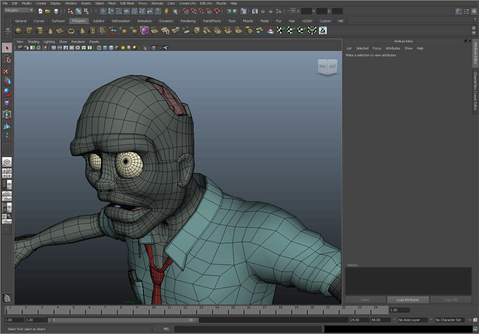Updated Interface
Maya’s interface has
now been enhanced with a new color scheme and functionality.
 Watch: Qt Interface
Watch: Qt Interface
These enhancements include:
|
|
New File Browser
Maya now has a new File
Browser window, which provides you with option box options
in line with the file browser itself.
Other options include
a streamlined display of your file system, more navigation options
relative to your current folder, and a list of recently opened folder.
|
|
|
New Shelf Editor
Maya now has a new Shelf
Editor window. This window features a more streamlined layout that
allows you to modify shelves and shelf items without navigating
between tabs. The editor now supports double-click commands, and editable
icon label colors and backgrounds.
|
|
|
Tabbed browsing for Attribute Editor
and Channel Box
You can now open the Channel
Box/Layer Editor and Attribute Editor simultaneously
as tabs which reside on the side of the panel.
|
|
|
Drag and Drop interactivity
You can dock and undock
menus and UI elements around different parts of the UI by dragging
and dropping their dotted edges.
You can also manually
resize UI elements by dragging them along their dotted edges.
|
|
|
New Color Chooser
Maya now has a new Color
Chooser window. This window features enhanced color history
tracking, multiple color selection methods, the ability to sample colors
directly from images, and customizable 256 color palettes that can
be saved and loaded. The Attribute Editor also
features a condensed version of the Color Chooser window
to make color selection quicker and easier than before.
|
For more information,
see
Interface overview.
Namespace Editor
|
|
You can now create and
edit namespaces from the Namespace Editor (Window
> General Editors > Namespace Editor).
|
Export Maya to Mudbox
|
|
You can now export directly from Maya to Autodesk Mudbox with a single click. This makes cross-application interaction faster and easier.
|
Relative namespaces
You can now refer to
namespaces relative to a specific namespace. This allows you to
streamline the Outliner and simplify MEL commands.
Asset and Container nomenclature
For Maya 2011, the term
container has been simplified to assets for any and all instances.
Assets with Transforms
You can now create two
types of assets in Maya. Assets with Transforms are asset nodes
with associated transforms, meaning you can transform them in the
scene and manipulate them in the DAG hierarchy like you would a
group node. Advanced Assets do not have an associated group transforms
and so you must publish nodes manually for them to interact with
the DAG hierarchy.
 Watch: Asset Enhancements
Watch: Asset Enhancements
Publish, unpublish, bind,
and unbind published nodes from the Attribute Editor
You can now publish,
unpublish, bind, and unbind published nodes directly from the Attribute
Editor by clicking the appropriate icon for each published node
in the Published Nodes section.
Publish nodes
You can now publish nodes
to a container that are not a Root Node, Parent Anchor,
or Child Anchor.
Remove Reference Edits
on a Loaded Reference
You can now use the Reference
Editor to remove reference edits without having to unload
the reference first.
Export to and Assign Offline
Files
You can now import and
export reference edits from a scene in Maya to and from an offline
file. This allows you to store edits of a source file in their own external
files or apply them to another file. For example, you can edit a
basic walk cycle into a strut, export the strut, and apply that
strut to a different character’s walk cycle.
 Watch: Offline Edits
Watch: Offline Edits
Additional formats for
custom icons
Maya now has expanded
support for file formats when creating custom icons for the shelf,
assets, the hypergraph, etc. The supported formats now include BMP,
GIF, JPG, JPEG, PNG, PBM, PGM, PPM, XBM, SVG, or XPM. Additionally,
images that are not the correct size are scaled now rather than
cropped.
Maya 64-bit now supported
on Mac OS X
Mac OS X users can access
considerably more memory to handle larger and more complex scenes
with the 64-bit version of Maya.
Maya uses IPv6 on Windows
Vista
Maya now uses IPv6 on
Windows Vista by default. To revert back to IPv4, set the environment
variable MAYA_IP_TYPE = ipv4.
Script Editor auto-completion
The script editor now
auto-completes recognized commands and object path names when you
enable the Command Completion and Object
Path Completion options.
New user interface commands
There are a number of
new UI related commands available. These include:
- dockControl
- toolBar
- treeLister
- loadUI
In addition, there are
also a number of new flags for existing commands including:
- -icon for confirmDialog
- -style for promptDialog
- -visChangeCommand for all scripts
- -saveMainWindowState and -restoreMainWindowState
for windowPref
- -itemAt and -visualRectAt for iconTextScrollList
- -droprectCallback for iconTextScrollList
- -numWidgets and -dumpWidgets for IsUI
A number of compatiblity
changes have also been made, including:
- -parent flag is editable now
- hotkey command can accept modifiers in
the -key flag argument
- -backgroundColor flag is respected on
all platforms for the control command
- -minimizeCommand and -restoreCommand
are respected on all platforms for the window command
- tabLayout control has scroll buttons
with right-click menus on all platforms if there is not enough space
to display tabs.
